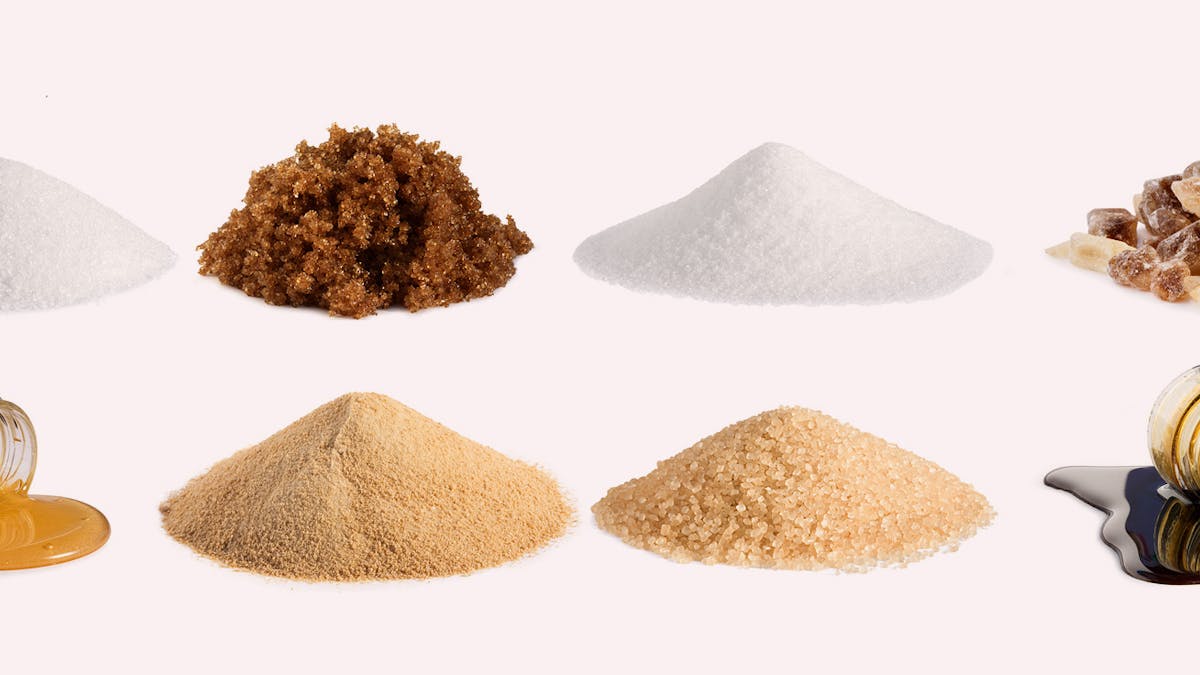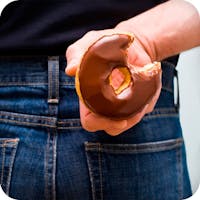How to use the nutrition facts label
One of the best ways to succeed on keto and low carb? Learning how to read the nutrition facts label on packaged foods.
This label can help you understand how healthy a packaged-food item really is, and allow you to compare products to see which is better suited to your low-carb lifestyle. It’s especially helpful for catching well-camouflaged sugars and comparing the carbohydrate content of similar items.
How to use the nutrition facts label:
1. Check for hidden sugars

Did you miss a cryptically named sugar hidden in that ingredient list?
Check the grams of sugar on the nutrition facts label (circled in pink). You’ll find this under the total carbohydrate grams, right after the fiber. The “sugars” number includes both naturally occurring sugars (like the fructose found in lemon juice) and added sugars (like the sugar or corn syrup added to some salad dressings).
Note: The newly-updated nutrition facts label does distinguish between naturally occurring and added sugars, but many smaller companies haven’t started using it yet.
The grams of sugar in each serving is shown. This E.V.O.O. Lemon Herb Dressing has 3 grams of sugar per serving (circled in pink, above).
The nutrition facts label always shows the number of servings per container (circled in red). If you plan to eat more than one serving, you’ll need to multiply the grams of sugar per serving by the number of servings you consume. If you pour about 4 tablespoons of dressing on your salad, that would be two servings, providing 6 grams of sugar.
That’s a lot of sugar for a generous pour of salad dressing. Perhaps you can find another brand with less sugar? (Or make a low-carb dressing at home with no sugar.)
2. Calculate net carbs
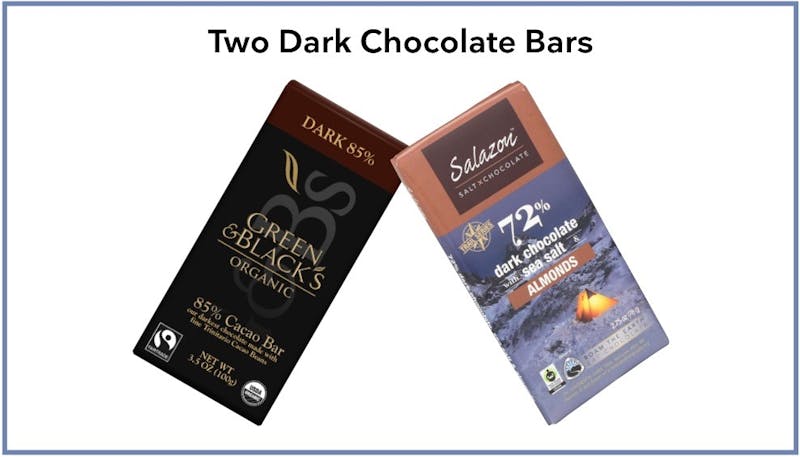


Many low-carb eaters use the nutrition facts label to calculate how many grams of net carbs1 are in their food. It’s a relatively easy calculation. Once you get the hang of it, it takes just seconds.
Calculating net carbs can be a great way to compare two similar products. For example, consider the label below for Green & Black’s 85% Cacao Bar.
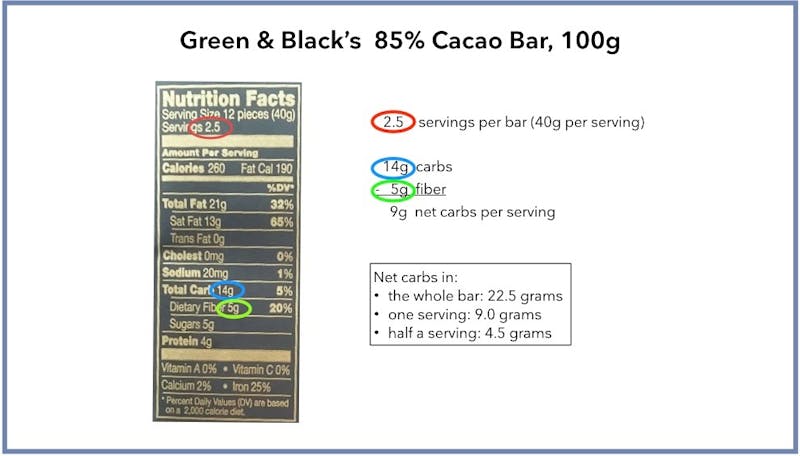


1. Check the serving size
First, look at the serving size (circled in red, above). How much chocolate is in one serving? A square? A cup? Half the package?
As you can see, the serving size for this chocolate is 40 grams, or 12 small squares.
2. Check carbs per serving
Second, check the total grams of carbohydrate per serving (circled in blue, above).
This chocolate has 14 grams of carbohydrates per serving.
3. Calculate net carbs per serving
Third, check the grams of dietary fiber per serving (circled in green, above). Subtract the fiber (green) from the total carbohydrates (blue) to get the net carbs.
This chocolate has 9 grams of net carbs per serving (14g carbs – 5g fiber = 9g net carbs).
Note: In the UK, Europe, and Australia, fiber has already been subtracted from the “total carbohydrate” value on nutrition labels (The amount of fiber that was subtracted is included on the line below). So if you’re looking at a nutrition label outside the US and Canada, you can skip this step because the net carbs have already been calculated for you.
4. Calculate how many net carbs you will eat
Finally, multiply the number of servings you’ll eat by the net carbs per serving.
Let’s say you want to eat six small squares of chocolate (about half a serving, or 20 grams). That’s 4.5 grams of net carbs (0.5 serving * 9g net carbs).
But if you were to eat the whole chocolate bar (2.5 servings), you would end up with 22.5 grams of net carbs (2.5 servings * 9g net carbs). That’s a LOT of carbs.
This chocolate bar is certainly low carb. And, when consumed in small amounts, it’s even keto approved. But buyer beware: it’s easy to overeat.
Let’s look at the nutrition facts label for another dark chocolate option, Salazon’s Dark Chocolate with Sea Salt and Almonds:
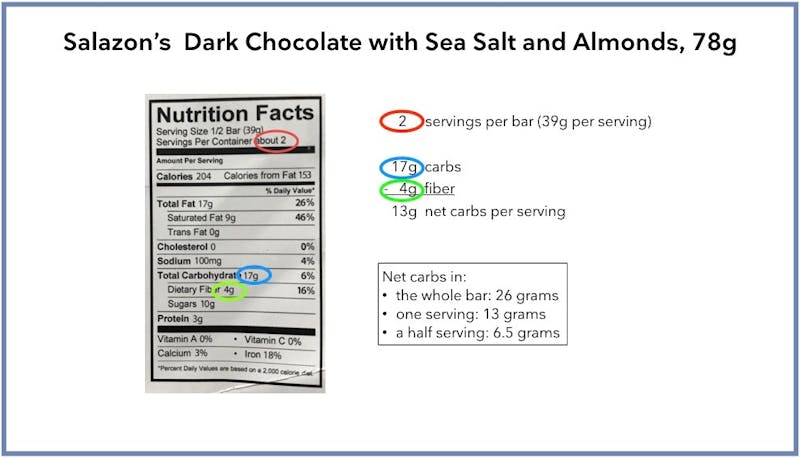


This bar has 13 grams of net carbs per serving. If you eat half a serving (1/4 of the bar, or 20 grams), you’ll consume 6.5 grams of net carbs. This may be fine for some low-carbers. But for others, especially keto eaters, this bar is too high in net carbs. Instead of placing it in the cart, it goes back on the shelf.
You can do this sort of a comparison with any two products. If you’re choosing a spaghetti sauce, why not quickly calculate which has fewer net carbs per cup? It might be the same, but not always.
If you are concerned about eating enough (or too much!) protein, you can use steps 1, 2 and 4,2 above, to calculate how much protein you would get from eating a serving or two of an item.
3. Consider macronutrient balance
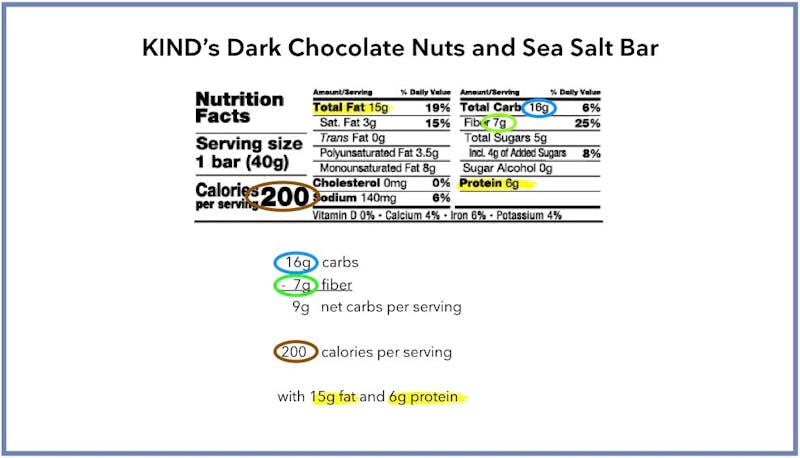


Another way to use the nutrition facts label is to consider the macronutrient balance of a product.
The energy in your food comes from three macronutrients: carbohydrates, fat, and protein. In essence, you want to answer the question, “How many of the calories come from net carbs?” But there is a shortcut to find your answer without having to pull out a calculator.
This is especially useful for a snack that will be eaten alone, rather than an item that will be consumed as part of a meal. It is also helpful for choosing between two snacks that have about the same amount of net carbs.
Very simply, after calculating net carbs, take a look at the grams of fat and protein on the nutrition facts label.
There are about 9 grams of net carbs in this KIND bar. Let’s say you are comparing it to another snack with 8 to 10 grams of net carbs. They are close. How do you choose?
Look at the grams of fat and grams of protein (highlighted in yellow, above). In general, the more protein or fat, the better. Products with more protein or fat will be higher in calories, but they also provide a more balanced source of energy and may prevent future snacking.
4. Consider energy density
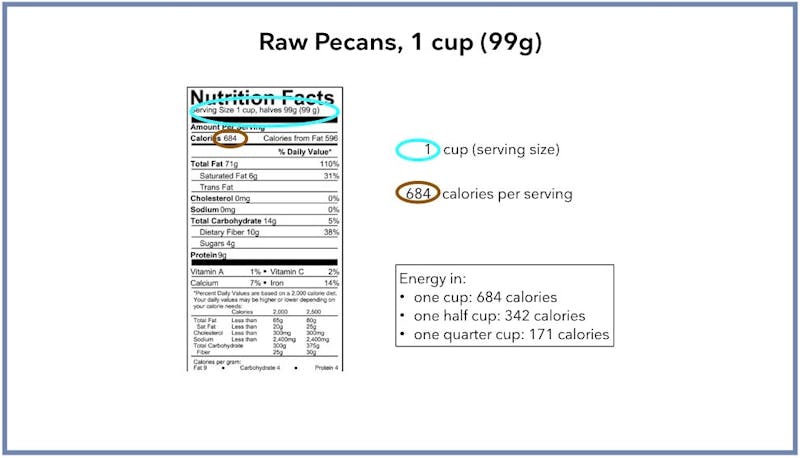


The nutrition facts label tells you how many calories (energy units) a product contains. Although low-carb eaters typically don’t have to bother counting calories (thank goodness!), it is nice to know how many are in a snack or meal component — just so you don’t overeat and regret it later.
Again, the calculation is very simple:
1. Check the serving size
The nutrition facts label always has both “Serving size” and “Servings per container/package” listed at the top. If you’re holding a snack pack that looks like it’s one serving, don’t assume that the nutrition values listed are for the entire bag. Always check. Is a serving one cup? Is it half a bag?
In this case, these raw pecans have a serving size of one cup (circled in turquoise).
2. Check calories per serving
The number of calories per serving is always listed near the top of the nutrition facts label.
In this case, a cup of pecans contains 684 calories (circled in brown).
3. Put the two together
Make a mental note — something like this: “One quarter cup of pecans has about 170 calories, so they’re a dense source of energy. I won’t need more than a handful in my lunch.”
Most of the fatty foods you eat on a low-carb or keto diet pack a lot of calories. They’re usually delicious, but often a little goes a long way. It can be easy to eat more than you need.
Although some low-carb or keto eaters pay no attention to calories, others find it helpful to have a general idea of how many calories are in a serving of food before they decide how much to eat.
The new nutrition facts label



The nutrition facts label recently got a makeover. It’s already found on products from major food producers, and you can expect to see it on items from smaller food companies by January of 2021.
Are the new labels better? Slightly. It’s easier to see the serving size and total calories, which is a plus. And manufacturers are now under greater pressure to designate a reasonable serving size for each product. The new labels call out added sugars separately from naturally occurring sugars. This is nice but not critical, since sugar is sugar.
There is certainly a lot more information on the nutrition facts label, but most of it isn’t that important.
Use the tips above to check for hidden sugars, and to calculate net carbs, macronutrient balance, or energy density. In most cases, looking at one or two of these will suffice; you will know what you need to know.
More
There are two companion guides with more information about navigating the grocery store and on ingredients to avoid:
In addition, click through to our main keto foods guide for basic info, and our keto diet food list for real-food inspired grocery shopping!
For more basics, check out our simple but thorough beginner’s guide to the keto diet:


